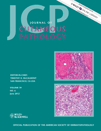
JOURNAL OF CUTANEOUS PATHOLOGY
Scope & Guideline
Exploring the Depths of Skin Disease Understanding
Introduction
Aims and Scopes
- Dermatopathology Research:
The journal emphasizes research in dermatopathology, exploring the histological and immunohistochemical characteristics of skin diseases, including tumors, inflammatory conditions, and infectious diseases. - Molecular and Genetic Studies:
There is a significant focus on the molecular and genetic underpinnings of skin pathologies, including gene fusions, mutations, and their implications for diagnosis and treatment. - Clinical Case Reports and Reviews:
The journal publishes detailed case reports and literature reviews that provide insights into rare and complex dermatological conditions, enhancing clinical knowledge and diagnostic accuracy. - Innovative Diagnostic Techniques:
The journal is committed to exploring and validating new diagnostic techniques, including advanced imaging and molecular assays, to improve the accuracy of dermatopathological diagnoses. - Educational Resources in Dermatopathology:
It serves as a resource for education and training in dermatopathology, offering insights into best practices, challenges, and advancements in the field.
Trending and Emerging
- Immunohistochemistry and Biomarkers:
There is a growing emphasis on the use of immunohistochemical markers for diagnosis, particularly in differentiating between melanoma and other neoplasms, underlining the importance of precise diagnostic tools. - Molecular Pathology and Genomics:
The trend towards integrating molecular pathology and genomic studies is evident, with increased publications focusing on gene mutations, fusions, and their clinical implications for skin cancers and other conditions. - Impact of Cancer Therapies on Skin:
Emerging themes include the study of dermatologic toxicities associated with cancer therapies, reflecting the intersection of oncology and dermatopathology. - Artificial Intelligence in Dermatopathology:
Interest in the application of artificial intelligence for diagnostic assistance in dermatopathology is on the rise, indicating a shift towards leveraging technology for improved diagnostic accuracy. - Post-Vaccination Dermatological Reactions:
Recent publications concerning skin reactions following COVID-19 vaccinations highlight a new focus area, addressing the need for awareness and understanding of vaccine-related dermatological effects.
Declining or Waning
- Traditional Histopathological Techniques:
While foundational, there is a noticeable decline in papers solely focused on traditional histopathological techniques without integration of molecular or genetic studies, as the field moves towards more advanced diagnostic methods. - General Dermatological Conditions:
Research on common dermatological conditions appears less frequently, possibly overshadowed by the increasing interest in rare and complex cases that highlight novel findings or therapeutic approaches. - Basic Dermatopathological Education:
There seems to be a waning focus on fundamental educational articles aimed at novice dermatopathologists, as the journal shifts towards more specialized and advanced topics.
Similar Journals

International Journal of Clinical and Experimental Pathology
Fostering Collaboration in the World of PathologyInternational Journal of Clinical and Experimental Pathology, published by E-CENTURY PUBLISHING CORP, serves as a vital resource for professionals in the field of pathology. With its ISSN 1936-2625, the journal has positioned itself within the competitive landscape of medical journals, achieving commendable rankings in Scopus, particularly in the categories of Pathology and Forensic Medicine (Rank #98/185) and Histology (Rank #38/58). Although its coverage in Scopus has been discontinued, the journal’s past contributions from 2009 to 2017 continue to be a touchstone for researchers interested in advancing their understanding of clinical and experimental pathology. The open-access format ensures accessibility to a wide audience, fostering collaboration and education in this essential medical discipline. By bridging clinical research and experimental findings, this journal plays a crucial role in disseminating knowledge and enhancing practices within pathology, making it an indispensable tool for researchers, professionals, and students alike.

Acta Dermatovenerologica Croatica
Pioneering Research for Skin Health and BeyondActa Dermatovenerologica Croatica is a premier journal dedicated to the fields of dermatology and venereology, published by the Croatian Dermatovenereological Society. Established in 1994, this journal has been a vital platform for disseminating research and advancements in the understanding and treatment of skin diseases and sexually transmitted infections. Although it is currently classified in the Q4 quartile for dermatology, infectious diseases, and miscellaneous medicine, it provides a unique opportunity for emerging researchers and seasoned professionals to contribute to a growing body of knowledge. Based in Zagreb, Croatia, the journal emphasizes free access to information that enhances clinical practices and scientific understanding among dermatologists and venereologists worldwide. As the journal approaches its 30th anniversary, it continues to aim for excellence in research quality, fostering collaboration, and innovating in the ever-evolving fields it represents.
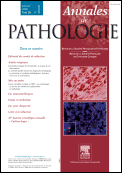
ANNALES DE PATHOLOGIE
Cultivating Scholarly Contributions in PathologyANNALES DE PATHOLOGIE, published by MASSON EDITEUR, stands as a pivotal resource in the field of pathology and forensic medicine, delivering critical insights since its inception in 1981. With an emphasis on advancing understanding and research applications within these domains, the journal is positioned to cater to a diverse audience of researchers, healthcare professionals, and students alike. While currently classified in the Q4 category within the pathway of Pathology and Forensic Medicine, it remains committed to fostering scholarly contributions and innovative research that contribute to the field's growth. Although it does not offer Open Access options, its print and electronic ISSNs (0242-6498 and 2213-008X) ensure availability for readership across global institutions. The Scopus ranking highlights its niche relevance, with a current rank of #189 out of 208 in its category, indicating a promising trajectory for future research endeavors. Published in France, ANNALES DE PATHOLOGIE invites contributions that engage the academic community and advance knowledge in pathology's most pressing matters.
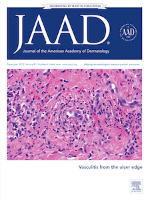
JOURNAL OF THE AMERICAN ACADEMY OF DERMATOLOGY
Bridging research and practice for dermatology professionals.JOURNAL OF THE AMERICAN ACADEMY OF DERMATOLOGY, published by Mosby-Elsevier, stands at the forefront of dermatological research and education. With an impressive impact factor and categorized as Q1 in Dermatology, this journal has established itself as a pivotal resource for healthcare professionals and researchers in the field. Since its inception in 1979, it has provided a platform for high-quality peer-reviewed articles, contributing significantly to advancements in dermatological science and practice through 2024. The journal commands an honorable position, ranking #8 out of 142 in the Scopus database's medicine dermatology category, placing it in the 94th percentile among its peers. Readers can access a wealth of cutting-edge studies, case reports, and reviews that address a broad spectrum of topics, from clinical dermatology to emerging therapies. In addition, the journal's commitment to excellence ensures it remains an essential tool for students, clinicians, and researchers dedicated to improving skin health and furthering knowledge in dermatology.

Journal of Hematopathology
Advancing knowledge in hematopathology.The Journal of Hematopathology, published by SPRINGER HEIDELBERG, serves as a vital resource in the fields of hematology, histology, and pathology. Established in 2008, this peer-reviewed journal aims to foster the exchange of knowledge among researchers, clinicians, and students by publishing original articles, reviews, and case studies that contribute to the understanding of hematopathological disorders. While the journal currently ranks in the fourth quartile in various categories including hematology and histology, it positions itself as a platform for emergent research and insights, addressing the evolving landscape of blood-related diseases. Although not an open access journal, it provides crucial access to research findings for professionals looking to stay abreast of developments in pathologic diagnostics and therapeutic strategies. As it continues to grow, the journal remains committed to enhancing the knowledge base and scientific discourse in hematopathology.

APPLIED IMMUNOHISTOCHEMISTRY & MOLECULAR MORPHOLOGY
Elevating research standards in laboratory science.Applied Immunohistochemistry & Molecular Morphology, published by Lippincott Williams & Wilkins, stands as a pivotal resource within the fields of histology, medical laboratory technology, and pathology. With an ISSN of 1541-2016 and an E-ISSN of 1533-4058, this journal has been contributing significant research and advancements since its inception in 1996. It serves a diverse audience, including researchers, professionals, and students, aiming to enhance the understanding of immunohistochemical techniques and molecular morphology. Recognized for its quality, it holds category quartiles of Q3 in histology and Q2 in medical laboratory technology and pathology and forensic medicine as of 2023. The journal's rigorous peer-review process ensures that only the most impactful findings are disseminated, thus advancing the education and practice in these critical domains of study. Though it is not an open-access journal, it remains essential for keeping abreast of the latest methodological innovations and applications in pathology and laboratory science, as evidenced by its respectable Scopus rankings and the continual convergence of groundbreaking research published through 2024.

Malaysian Journal of Pathology
Exploring the frontiers of disease mechanisms and diagnostics.Malaysian Journal of Pathology, published by the MALAYSIAN JOURNAL PATHOLOGY, stands as a pivotal resource in the fields of pathology and medicine, contributing rich insights since its inception in 1979. This peer-reviewed journal, based in Malaysia, is dedicated to disseminating original research, review articles, and case studies that advance the understanding of disease mechanisms and diagnostics. With a current impact factor reflecting its ranked positioning—Q4 in Cell Biology, Q4 in Histology, and Q3 in both Miscellaneous Medicine and Pathology & Forensic Medicine—this journal serves as an essential platform for researchers, clinicians, and students alike. Although it operates without open access, its scholarly rigor and contributions are well recognized, holding ranks such as #84 in Pathology and Forensic Medicine according to Scopus. The Malaysian Journal of Pathology is committed to fostering innovation and excellence in medical research, making it an invaluable tool for professionals seeking to stay abreast of significant advancements in the pathology domain.

Clinical Pathology
Championing Open Access to Transformative Medical KnowledgeClinical Pathology, an esteemed journal published by SAGE Publications Ltd, stands at the forefront of advancing knowledge in the intersection of histology, microbiology, and pathology. As an Open Access journal since 2019, it provides researchers and healthcare professionals seamless access to high-quality, peer-reviewed articles that contribute to the field's growing body of knowledge. With a focus on enhancing diagnostic methodologies and advancing clinical applications, Clinical Pathology serves a diverse audience eager to explore innovative research and practical insights. The journal currently holds Q3 status in Histology and Pathology and Forensic Medicine, and Q4 in Medical Microbiology, reflecting its commitment to rigorous scholarship within a competitive landscape. Its ranking in Scopus further positions it as a vital resource for professionals striving for excellence in clinical and experimental pathology. We invite researchers, students, and professionals to engage with the latest findings and share their valuable contributions to help propel the field forward.
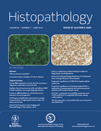
HISTOPATHOLOGY
Elevating Research in Forensic Medicine and DiagnosticsHISTOPATHOLOGY is a premier scholarly journal published by WILEY, targeting the fields of histology, pathology, and forensic medicine. With an ISSN of 0309-0167 and an E-ISSN of 1365-2559, this esteemed journal has maintained a strong academic presence since its inception in 1977. Boasting an impressive Q1 ranking in crucial categories such as Histology and Pathology, it ranks 13th out of 208 in Pathology and Forensic Medicine, and 5th out of 62 in Histology, reflecting its high impact and relevance within the scientific community. HISTOPATHOLOGY serves as a critical platform for disseminating significant research findings, reviews, and advancements in the diagnostic and therapeutic aspects of pathology. Although it does not operate under an open access model, its rigorous peer-review process ensures that published articles uphold the highest standards of scientific integrity. Scholars and practitioners alike benefit from the insights shared in this journal, as it aims to bridge the gap between laboratory science and clinical practice, fostering innovation and enhancing our understanding of disease mechanisms.
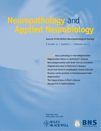
NEUROPATHOLOGY AND APPLIED NEUROBIOLOGY
Transforming Understanding through Neurobiological AdvancesNEUROPATHOLOGY AND APPLIED NEUROBIOLOGY is a premier journal dedicated to advancing the understanding of the intricate relationships between pathology and neurobiology. Published by Wiley since 1975, this journal has established itself as a crucial resource for researchers, clinicians, and students interested in the latest insights and developments in the fields of pathology, neurology, and neuroscience. With an impressive history of convergence extending to 2024, it boasts a Q1 ranking in multiple categories including Histology, Neurology, and Pathology, reflecting its high impact and reputation in the academic community. Additionally, it ranks 18th out of 208 in Pathology and Forensic Medicine with a remarkable 91st percentile, signifying its relevance and influence in medical research. While not open access, this journal provides valuable content that contributes significantly to the ongoing discourse in neurobiological advancements and is a vital reference for those engaged in this dynamic field.